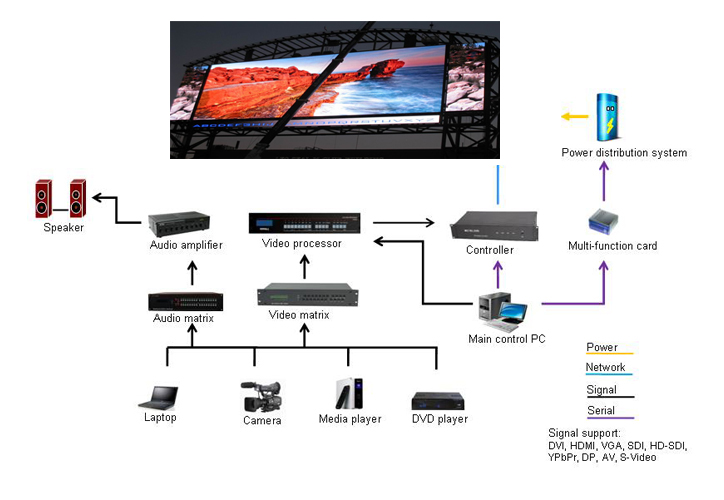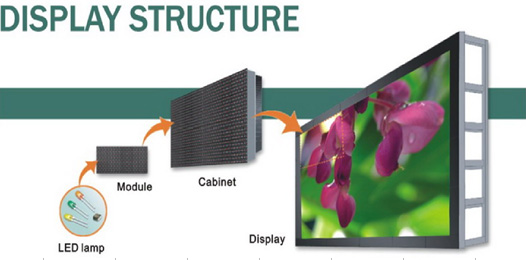A Guide to the Structure and Components of LED displays
LED displays have already embedded into our daily lives. They are within your sight wherever you go: workplace, shopping malls, restaurants, cinemas, and a lot more. But do you know the basics like structure and components of LED displays? Here technicians at STE LED will explain these fundamentals to you.
 Figure 1. An example of indoor LED video display’s structure and network
Figure 1. An example of indoor LED video display’s structure and network
What are the components of LED displays?
The LED display consists of two parts: the main led panel and the controller. To be more specific, the main led panel consists of multiple LED display units (Led cabinet or led panel) that can be connected together, which is the main body of the led display. Generally, the controller can also be divided into two parts: the control board (hardware) and the control system (software). The control board includes a sending card, a receiving card, and a computer. A variety of display panels (or cabinet units) with different specifications and controllers with different control technologies can form a variety of LED displays to meet different needs of different application environments (such as video processors and multifunction cards).
What are the structures of LED displays?
The structure of the screen:
 Figure 2. Simplified structure of LED display
Figure 2. Simplified structure of LED display
1. LED module: LED display, whether indoor or outdoor, is composed of led modules. LED modules include LED lights, drive ICs, PCB boards and module frames. Its size is not easy to change.
2. Display Panel: The display panel is the main body of the screen. It consists of a luminescent material and a drive circuit. The LED display panel of the indoor and outdoor screen is a unit cabinet.
3. Display Controller: The display controller mainly includes a sending card, a receiving card and a computer. The sending card should be installed inside the computer and the receiving card should be installed in the cabinet. Usually a cabinet requires a receiving card.
4. Switching Power Supply: It is used to convert 220V or 110V AC into various DC power to support various circuits.
5. Transmitting Cables: LED display data and various control signals generated by the main controller are transmitted to the screen through twisted pair.
6. Scanning Control Board: Its function is to buffer data and generate various scan signals and duty cycle gray control signals.
7. Special Video card and Multi-Function Card: They not only has the basic functions of computer video cards, but also can output RGB digital signals, lines, fields and blanking signals to the main controller. In addition to the same functions as a special video card, the multifunction card can also convert an input analog video signal into an RGB digital signal (i.e. a collection of video communications).
8. Other Information Sources and Equipment: including computers, televisions, blue-ray discs, DVDs, VCDs, video cameras and video recorders.
For more technical questions, please contact our team: info@ste-mart.com.